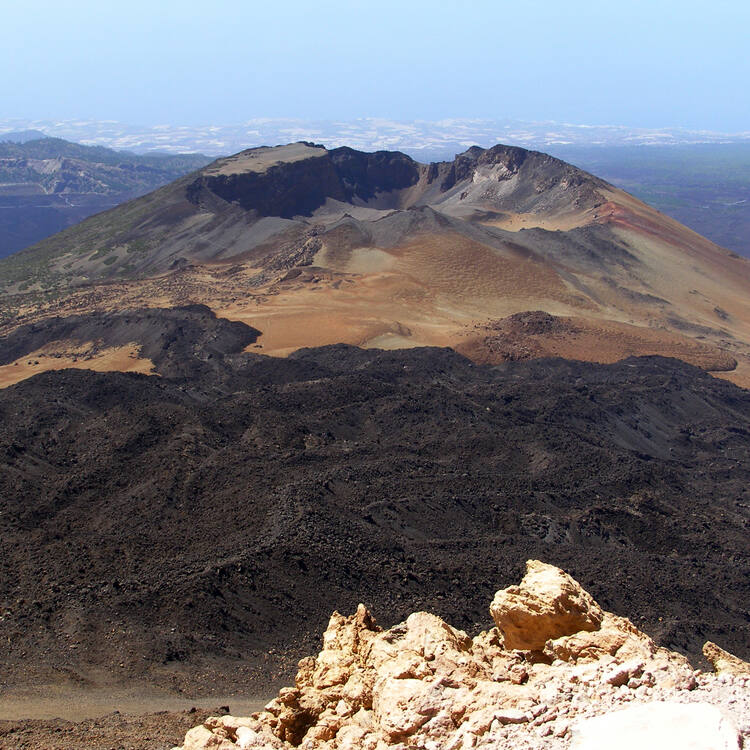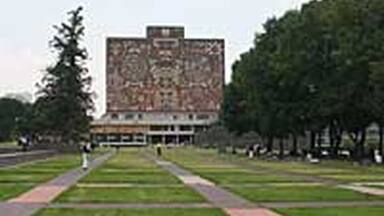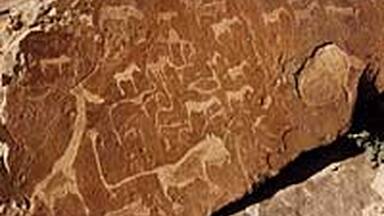Teide National Park
Teide National Park
Situated on the island of Tenerife, Teide National Park features the Teide-Pico Viejo stratovolcano that, at 3,718 m, is the highest peak on Spanish soil. Rising 7,500 m above the ocean floor, it is regarded as the world’s third-tallest volcanic structure and stands in a spectacular environment. The visual impact of the site is all the greater due to atmospheric conditions that create constantly changing textures and tones in the landscape and a ‘sea of clouds’ that forms a visually impressive backdrop to the mountain. Teide is of global importance in providing evidence of the geological processes that underpin the evolution of oceanic islands.
Description is available under license CC-BY-SA IGO 3.0
Parc national de Teide
Situé dans l’île de Tenerife, le site comporte le strato-volcan du Teide-Pico Viejo qui est le point culminant d’Espagne (3 718 m). S’élevant à environ 7 500 m au-dessus des fonds océaniques, le volcan est considéré comme la troisième plus haute structure volcanique du monde. Il est situé dans un environnement remarquable : les conditions atmosphériques confèrent au paysage des textures et teintes en perpétuel changement, cette « mer de nuages » forme un arrière-plan visuellement très impressionnant derrière la montagne. Le Teide est d’importance mondiale car il témoigne des processus géologiques qui sous-tendent l’évolution des îles océaniques.
Description is available under license CC-BY-SA IGO 3.0
حديقة تيد العامة الوطنية
تقع الحديقة في جزيرة تينيريف وتغطي 18990 هكتارا، كما أنها تشمل قمة تيد بيكو فييجو (بعلو 718 3 م)، أعلى قمم إسبانيا. تقع الحديقة على ارتفاع 7500 م من عمق المحيط، وتعدّ ثالث أعلى بنية بركانية في العالم. للموقع تأثير بصري مدهش نظراً إلى الشروط الجوية التي تنتج تموجات متواصلة في تربة وألوان المشهد الطبيعي، و"بحراً من الغيوم" يترك انطباعاً بصرياً لافتاً. ولهذه الحديقة أهمية كبيرة في توفير الأدلة حول النظم الجيولوجية التي تدعم تطور الجزر المحيطية. وبإدراجها تكتمل مجموعة الملكيات البركانية المدرجة على قائمة التراث العالمي، كحديقة هاواي البركانية العامة الوطنية.
source: UNESCO/CPE
Description is available under license CC-BY-SA IGO 3.0
泰德国家公园
泰德国家公园位于特内里费岛,占地18 990公顷,以泰德成层火山为特征。其海拔3718米,是西班牙的最高峰。离大洋洋底7500米,泰德自然公园被认为是世界第三高火山建筑物,周围景色壮观。由于气候条件使景观的特征和色调不断发生变化,以及云海对山的绝妙衬托,使得该遗址的视觉效果更为震撼。泰德火山公园具有全球重要意义,它见证了海岛演变的地质过程、并且是已列入《世界遗产名录》的火山遗产(如美国的夏威夷火山公园)的重要补充。
source: UNESCO/CPE
Description is available under license CC-BY-SA IGO 3.0
Национальный парк дикой природы Тейде
Восхитительный по своей красоте природный заповедник Тейде – это еще и кладезь информации о геологических процессах, определяющих эволюцию океанских островов. Его главная достопримечательность – самая высокая вершина Испании стратовулкан Тейде-Пико Виехо высотой в 3,718 м. Достигая высоты в 7,500 м по отношению к уровню морского дна, он числится третьим в списке высочайших вулканических образований мира. Национальный парк Тейде имеет всемирное значение: здесь сохранились следы геологических процессов, определяющих эволюцию океанских островов. Его изучение существенно дополнит данные, полученные в результате наблюдений за такими объектами всемирного наследия как Национальный парк «Гавайские вулканы» (США).
source: UNESCO/CPE
Description is available under license CC-BY-SA IGO 3.0
Parque Nacional del Teide
Situado en la isla de Tenerife, este sitio comprende esencialmente el estratovolcán del Teide-Pico Viejo, que con sus 3.718 metros sobre el nivel del mar es la cumbre más elevada de España. Esta estructura volcánica se alza a 7.500 metros por encima del fondo del océano, y se estima que es la tercera del mundo por su altura. El impacto visual del sitio se debe en gran parte a las condiciones atmosféricas que modifican continuamente las texturas y los tonos del paisaje, así como al espectáculo impresionante del “mar de nubes” que forma el telón de fondo de la montaña. La importancia mundial del Teide estriba en que es una viva muestra de los procesos geológicos subyacentes a la evolución de las islas oceánicas.
source: UNESCO/CPE
Description is available under license CC-BY-SA IGO 3.0
テイデ国立公園
source: NFUAJ
Nationaal park Teide
Source: unesco.nl
Outstanding Universal Value
Teide National Park, dominated by the 3,718 m Teide-Pico Viejo stratovolcano, represents a rich and diverse assemblage of volcanic features and landscapes concentrated in a spectacular setting.
Criterion (vii): Mount Teide is a striking volcanic landscape dominated by the jagged Las Cañadas escarpment and a central volcano that makes Tenerife the third tallest volcanic structure in the world. Within this landscape is a superlative suite of landforms that reveal different phases of construction and remodeling of the volcanic complex and highlight its unique geodiversity. The visual impact is emphasized by atmospheric conditions that create constantly changing textures and tones in the landscape and a ‘sea of clouds' that forms a visually impressive backdrop to the mountain.
Criterion (viii): Teide National Park is an exceptional example of a relatively old, slow moving, geologically complex and mature volcanic system. It is of global importance in providing diverse evidence of the geological processes that underpin the evolution of oceanic islands, and these values complement those of existing volcanic properties on the World Heritage List, such as the Hawaii Volcanoes National Park. It offers a diverse and accessible assemblage of volcanic features and landscapes in a relatively limited area. The area is a major centre for international research with a long history of influence on geology and geomorphology especially through the work of von Humboldt, von Buch and Lyell which has made Mount Teide a significant site in the history of volcanology.
The property is well managed and resourced, with a six-year management plan in place which is due for renewal in 2008. The property is afforded the same legal protection as other national parks in Spain and is surrounded by a buffer zone. Key management issues include the management of tourism, the potential impact of climate change, and effective coordination of management responsibility between national and regional levels of government.





